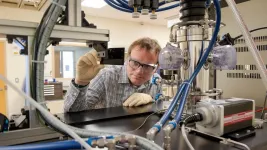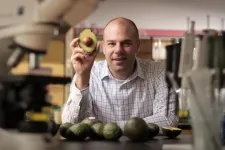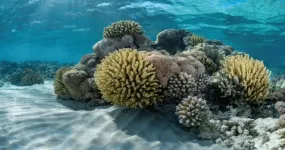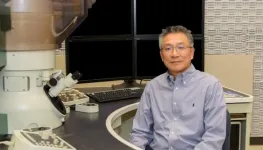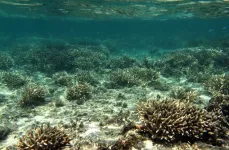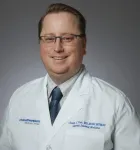(Press-News.org) Claiming that something has a defect normally suggests an undesirable feature. That's not the case in solid-state systems, such as the semiconductors at the heart of modern classical electronic devices. They work because of defects introduced into the rigidly ordered arrangement of atoms in crystalline materials like silicon. Surprisingly, in the quantum world, defects also play an important role.
Researchers at the U.S. Department of Energy's (DOE) Argonne National Laboratory, the University of Chicago and scientific institutes and universities in Japan, Korea and Hungary have established guidelines that will be an invaluable resource for the discovery of new defect-based quantum systems. The international team published these guidelines in Nature Reviews Materials.
"We are especially proud of our guidelines because intended users extend from veteran quantum scientists to researchers in other fields and graduate students hoping to join the quantum workforce." -- Gary Wolfowicz, assistant scientist in Argonne's Center for Molecular Engineering and Materials Science division, along with the University of Chicago Pritzker School of Molecular Engineering
Such systems have possible applications in quantum communications, sensing and computing and thereby could have a transformative effect on society. Quantum communications could distribute quantum information robustly and securely over long distances, making a quantum internet possible. Quantum sensing could achieve unprecedented sensitivities for measurements with biological, astronomical, technological and military interest. Quantum computing could reliably simulate the behavior of matter down to the atomic level and possibly simulate and discover new drugs.
The team derived their design guidelines based on an extensive review of the vast body of knowledge acquired over the last several decades on spin defects in solid-state materials.
"The defects that interest us here are isolated distortions in the orderly arrangement of atoms in a crystal," explained Joseph Heremans, a scientist in Argonne's Center for Molecular Engineering and Materials Science division, as well as the University of Chicago Pritzker School of Molecular Engineering.
Such distortions might include holes or vacancies created by the removal of atoms or impurities added as dopants. These distortions, in turn, can trap electrons within the crystal. These electrons have a property called spin, which acts as an isolated quantum system.
"Spin being a key quantum property, spin defects can hold quantum information in a form that physicists call quantum bits, or qubits, in analogy with the bit of information in classical computing," added Gary Wolfowicz, assistant scientist in Argonne's Center for Molecular Engineering and Materials Science division, along with the University of Chicago Pritzker School of Molecular Engineering.
For several decades, scientists have been studying these spin defects to create a broad array of proof-of-concept devices. However, previous research has only focused on one or two leading candidate qubits.
"Our field has had a somewhat narrow focus for many years," said Christopher Anderson, a postdoctoral scholar in the University of Chicago Pritzker School of Molecular Engineering. "It was like we only had a few horses in the quantum race. But now we understand that there are many other quantum horses to back, and exactly what to look for in those horses."
The team's guidelines encompass the properties of both the defects and the material selected to host them. The key defect properties are spin, optical (for example, how light interacts with the spin of the trapped electrons), and charge state of the defect.
Possible solid-state materials include not only the already well-studied few like silicon, diamond and silicon carbide but other more recent entries like various oxides. All these materials have different advantages and disadvantages laid out in the guidelines. For example, diamond is clear and hard, but expensive. On the other hand, silicon is easy to make devices with at low cost, but is more affected by free charges and temperature.
"Our guidelines are there for quantum scientists and engineers to assess the interplay between the defect properties and the selected host material in designing new qubits tailored to some specific application," Heremans noted.
"Spin defects have a central role to play in creating new quantum devices, whether they be small quantum computers, the quantum internet, or nanoscale quantum sensors," continued Anderson. "By drawing upon the extensive knowledge on spin defects to derive these guidelines, we have laid the groundwork so that the quantum workforce -- now and in the future -- can design from the ground up the perfect qubit for a specific use."
"We are especially proud of our guidelines because intended users extend from veteran quantum scientists to researchers in other fields and graduate students hoping to join the quantum workforce," said Wolfowicz.
The work also establishes the groundwork for designing scalable semiconductor quantum devices and dovetails well with Q-NEXT, a DOE-funded quantum information science research center led by Argonne. Q-NEXT's goal includes establishing a semiconductor quantum "foundry" for developing quantum interconnects and sensors.
"Our team's guidelines will act as a blueprint to help direct the Q-NEXT mission in designing the next generation of quantum materials and devices," said David Awschalom, senior scientist in Argonne's Materials Science division, Liew Family Professor of Molecular Engineering at the University of Chicago Pritzker School of Molecular Engineering, and director of both the Chicago Quantum Exchange and Q-NEXT. "When it comes to quantum technologies with spins, this work sets the stage and informs the field how to move forward."
The team's guidelines appear in a paper entitled "Qubit guidelines for solid-state spin defects" and published in Nature Reviews Materials. In addition to Heremans, Wolfowicz, Anderson and Awschalom, authors include Shun Kanai (Tohoku University, Japan), Hosung Seo (Ajou University, Korea), Adam Gali (Budapest University of Technology and Economics, Hungary) and Giulia Galli (Argonne and University of Chicago).
This research was primarily supported by the DOE Office of Science.
Argonne National Laboratory seeks solutions to pressing national problems in science and technology. The nation's first national laboratory, Argonne conducts leading-edge basic and applied scientific research in virtually every scientific discipline. Argonne researchers work closely with researchers from hundreds of companies, universities, and federal, state and municipal agencies to help them solve their specific problems, advance America's scientific leadership and prepare the nation for a better future. With employees from more than 60 nations, Argonne is managed by UChicago Argonne, LLC for the U.S. Department of Energy's Office of Science.
The U.S. Department of Energy's Office of Science is the single largest supporter of basic research in the physical sciences in the United States and is working to address some of the most pressing challenges of our time. For more information, visit https://energy.gov/science.
INFORMATION:
A compound in avocados may ultimately offer a route to better leukemia treatment, says a new University of Guelph study.
The compound targets an enzyme that scientists have identified for the first time as being critical to cancer cell growth, said Dr. Paul Spagnuolo, Department of Food Science.
Published recently in the journal Blood, the study focused on acute myeloid leukemia (AML), which is the most devastating form of leukemia. Most cases occur in people over age 65, and fewer than 10 per cent of patients survive five years after diagnosis.
Leukemia cells have higher amounts of an enzyme called VLCAD involved in their metabolism, said Spagnuolo.
"The cell relies on that pathway to ...
Coral reefs provide shelter, sustenance and stability to a range of organisms, but these vital ecosystems would not exist if not for the skeletal structure created by stony corals. Now, KAUST scientists together with an international team have revealed the underlying genetic story of how corals evolved from soft-bodied organisms to build the myriad calcified structures we see today.
"While the processes involved in coral calcification are well understood, it is less clear how corals' ability to grow calcium carbonate skeletons actually evolved," says Xin Wang, a former KAUST Ph.D. student who worked on the project under the supervision of Manual Aranda.
"How did a squishy anemone-like organism begin to build reefs?" ...
CLEVELAND - In a Correspondence article published in the April 29, 2021 issue of the New England Journal of Medicine, researchers from University Hospitals (UH) Cleveland Medical Center, and New York Presbyterian Hospital - Weill Cornell Medicine in New York, found a substantial reduction in the use of minimally invasive surgery for cervical cancer after publication of the results a major study called the Laparoscopic Approach to Cervical Cancer (LACC) in November 2018.
The earlier study, which compared minimally invasive surgery with open abdominal radical hysterectomy in patients with early-stage cervical cancer, found that minimally invasive surgery was associated with worse disease-free and overall ...
LAWRENCE -- Researchers commonly work with the criminal justice system to implement reforms, bringing with them the latest science and data pointing to why a certain practice will help improve outcomes. New research from the University of Kansas shows if community corrections agencies are to sustain evidence-based reforms, they need to view them as legitimate.
Researchers worked with eight federal community corrections agencies to implement Contingency Management, an evidence-based practice used to help people convicted of drug offenses set and achieve goals to end addiction, avoid repeat offenses and increase pro-social behavior. Such evidence-based practices and reforms are frequently put in place across the criminal justice system.
Shannon Portillo"We've ...
Nanopore technology shows promise for making it possible to develop small, portable, inexpensive devices that can sequence DNA in real time. One of the challenges, however, has been to make the technology more accurate.
Researchers at The University of Texas at Dallas have moved closer toward this goal by developing a nanopore sequencing platform that, for the first time, can detect the presence of nucleobases, the building blocks of DNA and RNA. The study was published online Feb. 11 and is featured on the back cover of the April print edition of the ...
A study by University of Guam researchers has found that shade can mitigate the effects of heat stress on corals. The study, which was funded by the university's National Science Foundation EPSCoR grant, was published in February in the peer-reviewed Marine Biology Research journal.
"We wanted to see what role light has in coral bleaching," said UOG Assistant Professor Bastian Bentlage, the supervisor and co-author of the study. "Usually, people talk about temperature as a cause for bleaching, but we show that both light and temperature work together."
Previous UOG research led by Laurie J. Raymundo found that more than one-third of all coral reefs in Guam were killed from 2013 to 2017 over the ...
COLUMBUS, Ohio - Hispanic Americans have died of COVID-19 at a disproportionately high rate compared to whites because of workplace exposure to the virus, a new study suggests.
It's widely documented that Hispanics are overrepresented among workers in essential industries and occupations ranging from warehousing and grocery stores to health care and construction, much of which kept operating when most of the country shut down last spring.
The analysis of federal data showed that, considering their representation in the U.S. population, far higher percentages of Hispanics of working ...
New Haven, Conn. -- Researchers at Yale and Princeton say the scientific community sorely needs a new way to compare the cascading effects of ecosystem loss due to human-induced environmental change to major crises of the past.
For too long, scientists have relied upon metrics that compare current rates of species loss with those characterizing mass extinctions in the distant past, according to Pincelli Hull, an assistant professor of Earth and planetary sciences at Yale, and Christopher Spalding, an astrophysicist at Princeton.
The result has been projections of extinction rates in the next few decades that are on the order ...
DALLAS - April 28, 2021 - Depression screening among cancer patients improved by 40 percent to cover more than 90 percent of patients under a quality improvement program launched by a multidisciplinary team at UT Southwestern Medical Center and Southwestern Health Resources.
Cancer patients with depression are at an increased risk of mortality and suicide compared with those without depression. Although rates vary based on cancer type and stage, depression is estimated to affect 10 to 30 percent of patients with cancer compared with 7 to 8 percent of adults without a diagnosis or history of cancer, and impact both men and women equally.
Due to the higher risk, medical ...
LAWRENCE -- For thousands of years during the last ice age, generations of maritime migrants paddled skin boats eastward across shallow ocean waters from Asia to present-day Alaska. They voyaged from island to island and ultimately to shore, surviving on bountiful seaweeds, fish, shellfish, birds and game harvested from coastal and nearshore biomes. Their island-rich route was possible due to a shifting archipelago that stretched almost 900 miles from one continent to the other.
A new study from the University of Kansas in partnership with universities in Bologna and Urbino, Italy, documents the newly named Bering Transitory Archipelago and then points to how, when and where the first Americans ...
